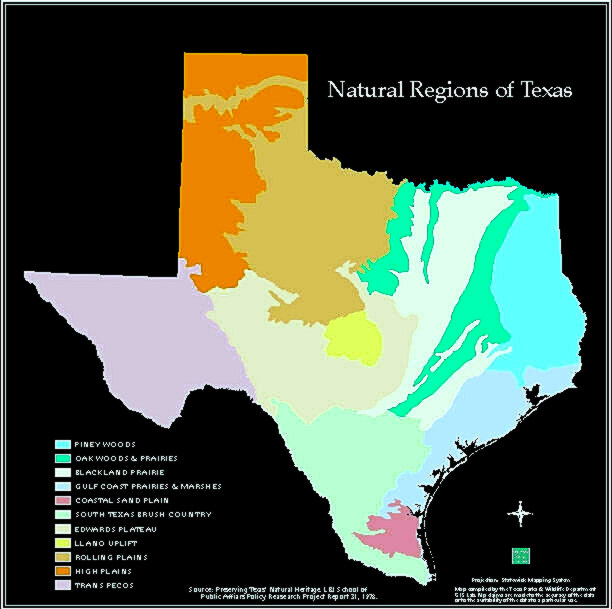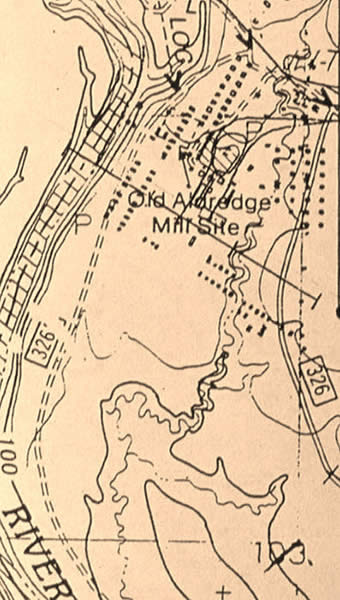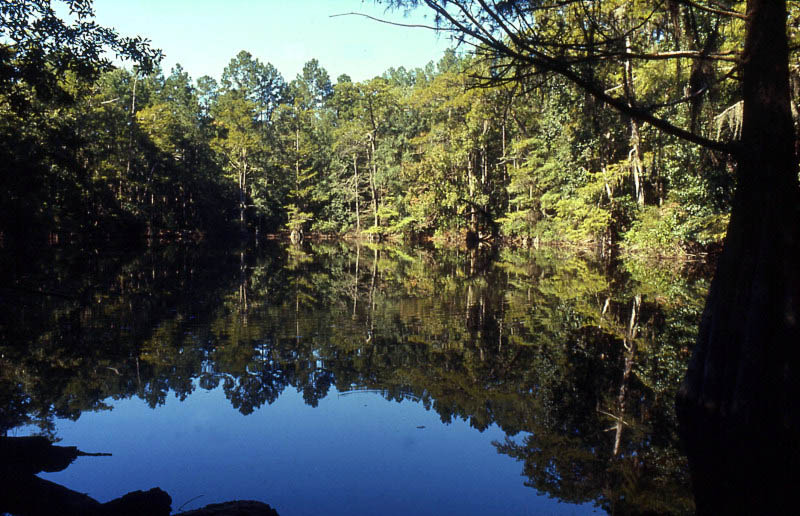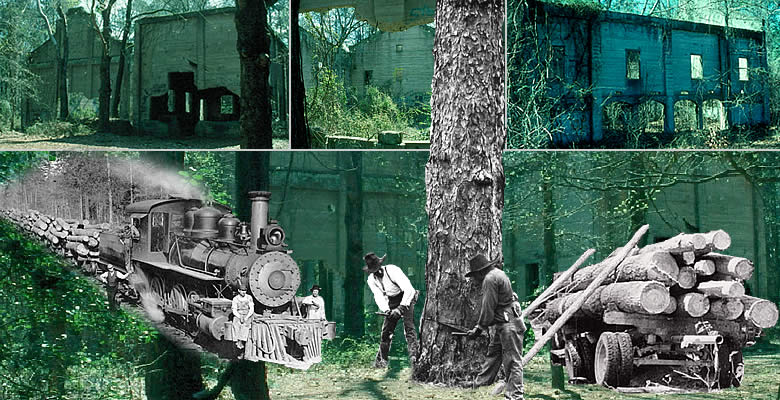
The Pineywoods region—shaded
in jade blue on this map—extends downward across
a wide swath of East Texas to the northern Gulf Coast.
Map courtesy The University of Texas General Libraries,
Texas Map Collection. Click to enlarge.
|

Tall stands of yellow pine dwarf
a man in East Texas. In the virgin forests—known
to Native Americans and early settlers—trees reached
150 feet in height and up to 5 feet in diameter. Photo
courtesy of Center for American History, University
of Texas at Austin, East Texas Collection. Click to
see full image.
|

Neatly laid out in a bend of the
Neches River, the Aldridge town and sawmill is shown
during its heyday in this early map of Jasper County,
Texas. Typical of many milltowns, Aldridge flourished
until the timber was depleted. (Note that the town name
is spelled differently on this map.)
|
|
One of the few sites of its type
with significant structural remains,
the Aldridge Sawmill has been listed
on the National Register of Historic
Places and has been investigated by
volunteers and professional archeologists
through the USDA Forest Service Passport
in Time project.
|
|
Deep within the pine forests of East Texas,
a few ruined buildings—their concrete walls overgrown,
crumbling, and splotched with graffiti—and a maze of
stone foundations near a pond are all that remain of what
was once Aldridge, a bustling sawmill and neatly laid-out
company town. It is hard to imagine that less than a century
ago in these quiet woods, steam and sawdust once filled the
air. Shouts of mill workers competed with the metallic din
of machinery and the blaring whistles of trains hauling lumber
to far-away markets. Forest crews—the choppers, flatheads,
and buckers who harvested the enormous pines from woods nearby—came
to town on occasion, joining the sawyers, trimmers, planers,
managers, merchants, teachers, preachers, and their families
who made up the Aldridge populace.
Like many other early lumber factories in this
richly resourced region, Aldridge was a temporary phenomenon,
a mill complex and community created to serve a single purpose—to
extract and process timber resources. Sawmills were built,
forests harvested, and communities reduced to ghost towns
within the sweep of half a century or less. Yet, during its
brief heyday, the Aldridge sawmill produced thousands of board
feet of yellow pine lumber a day and supported hundreds of
workers and their families. Collectively, Aldridge and the
many East Texas sawmills like it played a significant role
in the American economy—providing the lumber needed to
build the towns and cities across Texas and other parts of
the nation.
The "Bonanza" period of East Texas
logging began in the late 1880s and lasted until the late
1920s. Well before this time, national population growth and
industrial development had exhausted the last remaining forests
in the northern United States and created a huge demand for
southern lumber and other timber products. The largely untapped
timber potential of East Texas attracted new investment capital
to finance larger, more powerful logging operations.
Timber production shifted from the small, relatively
primitive, owner-operated sawmills of the mid-19th century
to more industrialized, technologically sophisticated operations
employing hundreds of people. The new operators, some of them
corporations, came to dominate the East Texas economy in the
early 20th century. They built their own railroads into the
forests, connecting their remote sawmills and "company
towns" with shipping points for their timber products.
An estimated 615 sawmills were operating in
Texas in 1910, according to the Texas Almanac. The
impact of this activity was dramatic. Approximately 18 million
acres worth of "Pineywoods" timber was cut during
the 50 years between 1880 and 1930, an amount estimated to
represent 59 billion board feet of lumber. Most of
the pristine pine forests were cut out within a few decades.
Depletion of the state's timber resources, combined with the
impact of the Great Depression, brought an end to the "Bonanza"
period. Some of the large timber companies moved their operations
to the forests of the Pacific Northwest, while others went
into bankruptcy.
Federal legislation authorized the purchase
of cut-over timber lands, and in the 1930s, the U.S. Forest
Service began to appraise and purchase such lands in East
Texas. These include what are now the Angelina National Forest,
Davy Crockett National Forest, Sabine National Forest, and
Sam Houston National Forest. Over the past 70 years, the Forest
Service has replanted these lands and replenished the East
Texas timber reserves, implemented sustained yield practices,
and instituted programs to conserve the soil, water, and other
natural resources of the region.
The Aldridge Sawmill, which operated between
1905 and 1923, was capable of producing 125,000 board feet
of lumber per day, making it a large operation for its time.
But, plagued by fires and eventually the depletion of nearby
timber resources, the Aldridge operation was abandoned. Over
time, its houses and factory buildings were picked over, some
torn down for usable construction materials and machinery,
others left to slowly succumb to the forces of nature. Today,
the site continues to be threatened by vandals and treasure
seekers.
Located within the boundaries of the modern
Angelina National Forest, the Aldridge Sawmill and Township
historical site represents the combination of industrial technology
and capital investment that opened the Pineywoods to economic
development in the early 20th century. As one of the few sites
of its type with significant structural remains, Aldridge
has been listed on the National Register of Historic Places
and has been investigated by volunteers and professional archeologists
through the USDA Forest Service Passport in Time program.
In the following exhibits, we explore the Forest
Lands and the types of trees used in the still-thriving
lumber industry. In Logging
in the Pineywoods, the fascinating history of logging
and its significance in the development of East Texas is reviewed.
In Investigating the Aldridge
Legacy, we take a close-up look at Aldridge as representative
of the many sawmill operations that thrived for a relatively
brief moment during the logging bonanza, and we learn more
about the measures being taken to preserve this and other
historic forest sites. In Learning
about Logging, teachers and students will find links to
a variety of educational materials and curricula focused on
forests and their resources and the logging industry. Teaching about Sawmills is a lesson for 7th-grade students correlated to this exhibit that gives 7th-grade students an opportunity to practice math skills while becoming familiar with Texas’ “Boom & Bust” economy and the natural history and geography of the east Texas Piney Woods. The
Aldridge Sawmill/Logging History exhibits on Texas Beyond
History are based on reports written by the USDA Forest
Service archeologists during their historical research
and investigations of the site. The exhibits are supported
by a grant from the Temple-Inland Foundation.
|

Trees and bushes
crowd the interior of what was once
the boiler building at Aldridge Sawmill.
Photo courtesy USDA Forest Service.
|
|
Approximately 18 million acres worth of Pineywoods
timber was cut during the "Bonanza" period
between 1880 and 1930, an amount estimated to be the
equivalent of 59 billion board feet of lumber.
|

Dark pines and tall cypress are mirrored
on the surface of this quiet pond in the Angelina National
Forest in East Texas, near the Aldridge site. Photo
by John Suhrstedt, courtesy Texas Department of Transportation.
Click to enlarge.
|

Under the watchful
eye of a USDA Forest Service supervisor,
volunteers in the Passport in Time program
sort through artifacts excavated during
the 1996-97 project at Aldridge Sawmill.
Through the efforts of staff archeologists
and volunteers, historic forest sites
are documented and investigated, helping
to preserve the forest legacy and increase
public awareness. Photo courtesy USDA
Forest Service. Click to see full image.
|

Vandals have painted graffiti on
many of the walls at the Aldridge site, a highly destructive
activity that Forest Service staff hope to discourage
with greater education efforts. Photo courtesy of USDA
Forest Service.
|
|







